NCERT Solutions for Class 7 Maths Ganita Prakash Chapter 4 Expressions using Letter-Numbers for Session 2025-26. It helps students understand the basics of algebra through real-life examples and visual patterns. Class 7 Math Chapter 4 explains how to form and simplify algebraic expressions using letter-numbers, explore patterns and use formulas effectively. NCERT Textbook solutions offer clear, step-by-step explanations that make concepts easier to grasp, enabling students to strengthen their foundation in algebra and apply it confidently in various mathematical problems.
Class 7 Maths all Chapters
Class 7 Maths Ganita Prakash Chapter 4 Solutions
Page 81
4.1 The Notion of Letter-Numbers
Example 1: Shabnam is 3 years older than Aftab. When Aftab’s age was 10 years, Shabnam’s age was 13 years. Now Aftab’s age is 18 years, what will Shabnam’s age be?
See SolutionShabnam’s age = Aftab’s age + 3
= 18 + 3
= 21 years.
Given Aftab’s age, how will you find out Shabnam’s age?
See SolutionAdd 3 to Aftab’s age.
Can we write this as an expression?
See SolutionYes.
Shabnam’s age = Aftab’s age + 3.
Page 82
Given the age of Shabnam (s), write an expression to find Aftab’s age (a).
See SolutionWe know Aftab is 3 years younger than Shabnam.
Expression: Aftab’s age = Shabnam’s age – 3.
Using letter-numbers: a = s – 3.
Use this expression (a = s – 3) to find Aftab’s age if Shabnam’s age is 20.
See SolutionSubstitute s = 20 into the expression:
a = 20 – 3
= 17.
Aftab’s age would be 17 years.
Example 2: Parthiv is making matchstick patterns of Ls (2 sticks per L).
How many matchsticks are needed to make 5 Ls?
See Solution5 x 2 (= 10 matchsticks).
How many matchsticks are needed to make 7 Ls?
See Solution7 x 2 (= 14 matchsticks).
How many matchsticks are needed to make 45 Ls?
See Solution45 x 2 (= 90 matchsticks).
Example 3. Ketaki prepares coconut-jaggery laddus. Price of a coconut is Rs 35 and price of 1 kg jaggery is Rs 60. How much should she pay if she buys 10 coconuts and 5 kg jaggery?
See SolutionCost = (Cost of coconuts) + (Cost of jaggery)
= (10 x 35) + (5 x 60)
= 350 + 300
= ₹650.
How much should she pay if she buys 8 coconuts and 9 kg jaggery?
See SolutionCost = (8 x 35) + (9 x 60)
= 280 + 540
= ₹820.
Write an algebraic expression to find the total amount to be paid for a given number of coconuts (‘c’) and quantity of jaggery (‘j’ kg).
See SolutionCost of coconuts = c x 35 (or 35c)
Cost of jaggery = j x 60 (or 60j)
Total Cost = Cost of coconuts + Cost of jaggery
Algebraic Expression: 35c + 60j.
Use this expression (35c + 60j) to find the total amount to be paid for 7 coconuts and 4 kg jaggery.
See SolutionSubstitute c = 7 and j = 4 into the expression:
Total Cost = (35 x 7) + (60 * 4)
= 245 + 240
= ₹485.
Writing expression as sum of terms: 35c + 60j = (35c) + (60j).
Example 4:We are familiar with calculating the perimeters of simple shapes. Write expressions for perimeters.
See SolutionPerimeter Formulas
Perimeter of a square = 4 times the length of its side.
Expression: 4 x q (or 4q), where q is the side length.
What is the perimeter of a square with side length 7 cm? Use the expression to find out.
See SolutionSubstitute q = 7 into the expression 4q:
Perimeter = 4 x 7 = 28 cm.
Page 84
Figure it Out
1. Write formulas for the perimeter of:
(a) a triangle with all sides equal.
See SolutionLet the side length be ‘s’.
Perimeter P = s + s + s = 3s.
Formula: P = 3s.
(b) a regular pentagon.
See SolutionA regular pentagon has 5 equal sides.
Let the side length be ‘p’.
Perimeter P = p + p + p + p + p = 5p.
Formula: P = 5p.
(c) a regular hexagon.
See SolutionA regular hexagon has 6 equal sides.
Let the side length be ‘h’.
Perimeter P = h + h + h + h + h + h = 6h.
Formula: P = 6h.
2. Munirathna has a 20 m long pipe. He joins another pipe of some length (‘k’ meters) to this one. Give the expression for the combined length of the pipe.
See SolutionCombined Length = Initial Length + Added Length. Expression: 20 + k meters.
3. What is the total amount Krithika has, if she has the following numbers of notes of ₹100, ₹20 and ₹5? Complete the following table:
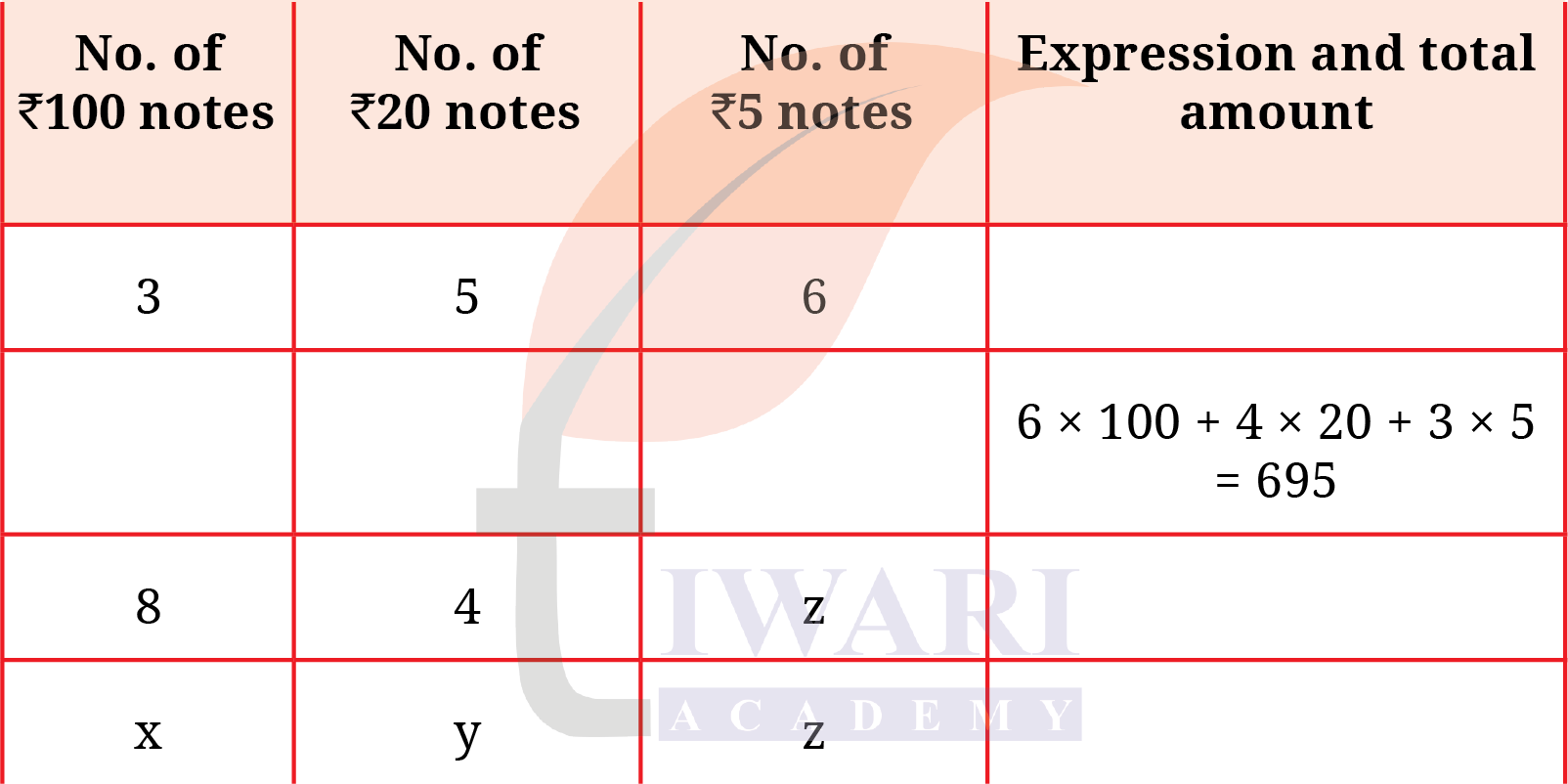
Answer:
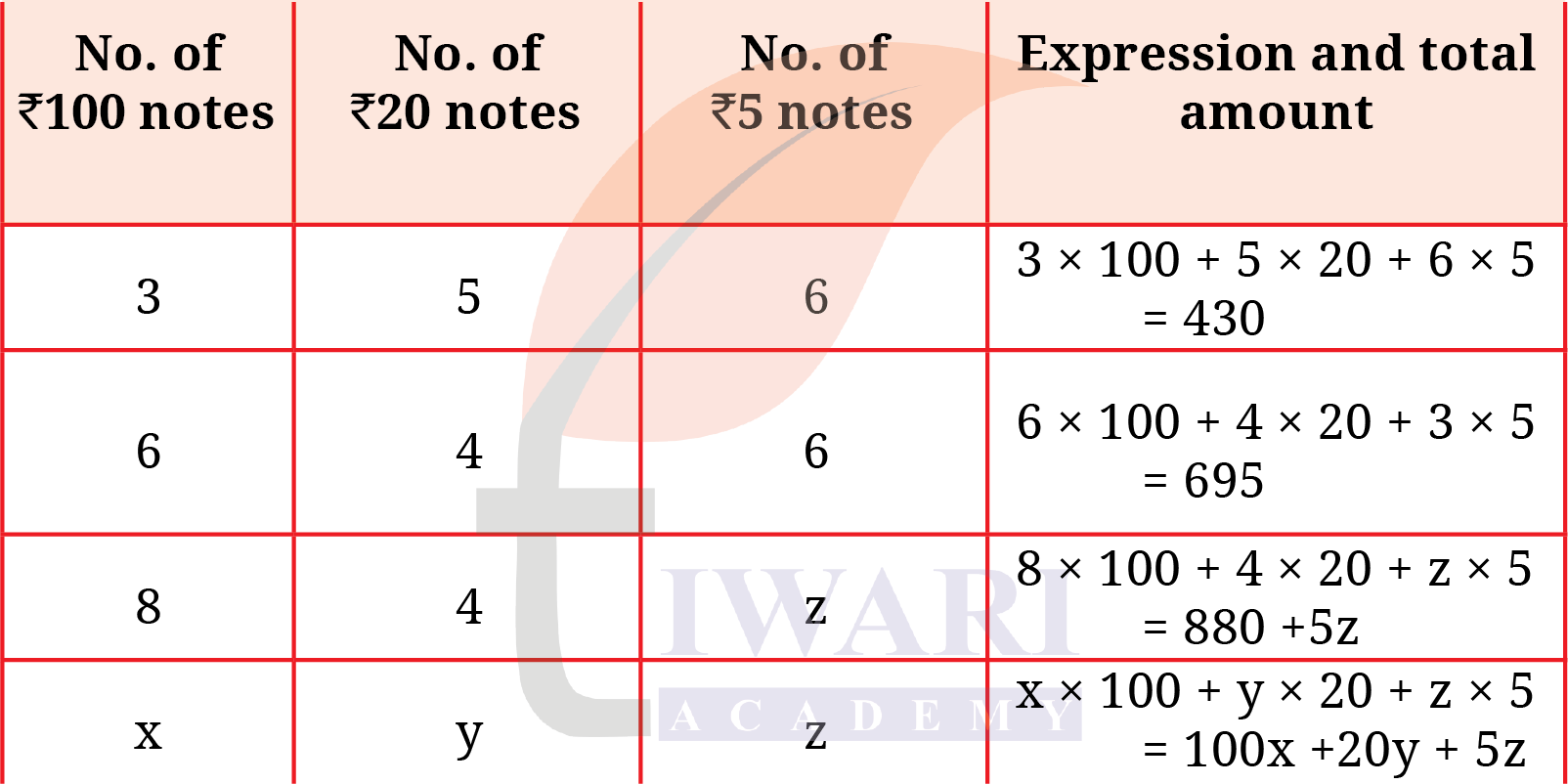
4. Venkatalakshmi owns a flour mill. It takes 10 seconds for the roller mill to start running. Once it is running, each kg of grain takes 8 seconds to grind into powder. Which of the expressions below describes the time taken to complete grind ‘y’ kg of grain, assuming the machine is off initially?
Options:
(a) 10 + 8 + y (b) (10 + 8) × y
(c) 10 × 8 × y (d) 10 + 8 × y
(e) 10 × y + 8
See SolutionTotal Time = Startup Time + Grinding Time.
Startup Time = 10 seconds.
Grinding Time = (Time per kg) x (Number of kg) = 8 × y seconds.
Total Time = 10 + 8y seconds.
Matching option: (d) 10 + 8 × y.
5. Write algebraic expressions using letters of your choice.
(a) 5 more than a number
See AnswerLet the number be n.
Expression: n + 5.
(b) 4 less than a number
See AnswerLet the number be x.
Expression: x – 4.
(c) 2 less than 13 times a number
See AnswerLet the number be y.
Expression: 13y – 2.
(d) 13 less than 2 times a number
See AnswerLet the number be z.
Expression: 2z – 13.
6. Describe situations corresponding to the following algebraic expressions:
(a) 8x + 3y
See SolutionSituation example: Calculating the total cost of buying x notebooks at ₹8 each and y pens at ₹3 each.
(b) 15j – 2k
See SolutionSituation example: Calculating the remaining amount of juice if you start with 15 jugs containing j litres each and pour out 2 kettles containing k litres each.
7. In a calendar month, if any 2 × 3 grid full of dates is chosen… write expressions for the dates in the blank cells if the bottom middle cell has date ‘w’.
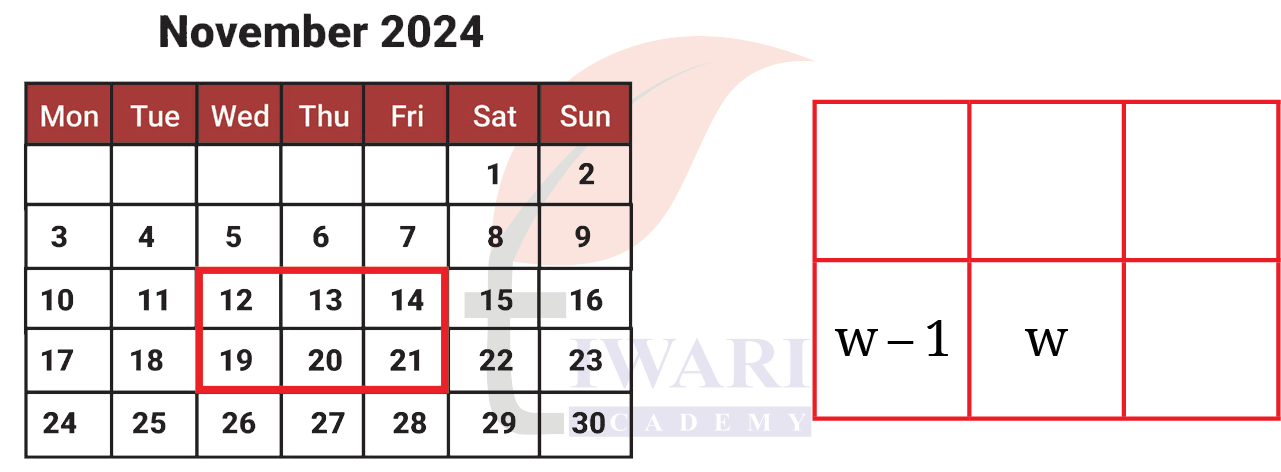
See SolutionAssuming a standard calendar layout and a 2×3 grid:
Top row: [w-8] [w-7] [w-6]
Bottom row:[w-1] [ w ] [w+1]
The expressions for the dates are:
– Cell to the left of w: w-1
– Cell to the right of w: w+1
– Cell directly above w: w-7
– Cell top-left: w-8
– Cell top-right: w-6
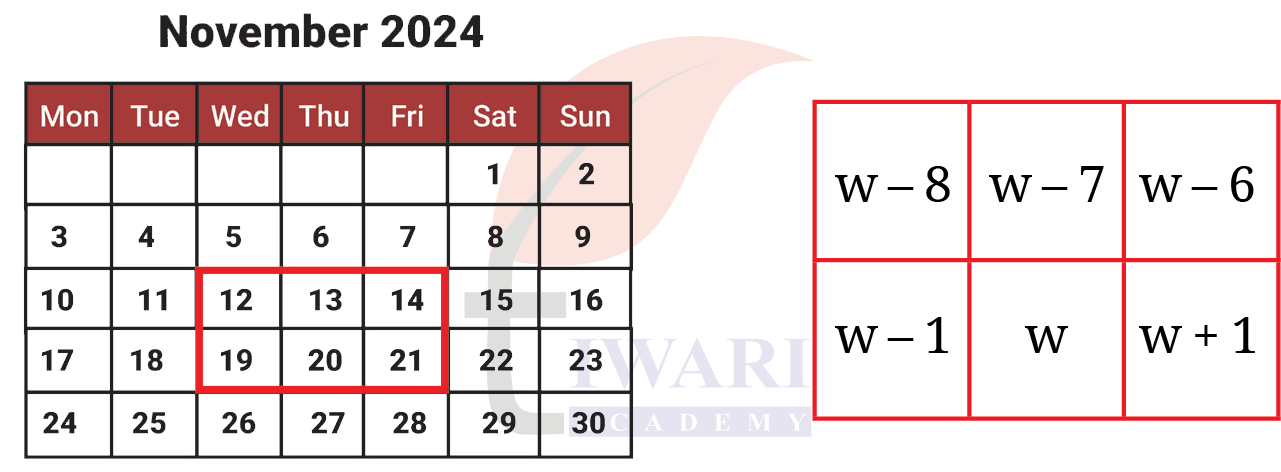
4.2 Revisiting Arithmetic Expressions
The values of the following expressions:
1. 23 – 10 × 2
See Solution23 – 10 × 2
= 23 + –10 × 2
= 23 + –20
= 3
2. 83 + 28 – 13 + 32
See SolutionGrouping like terms or convenient pairs:
(83 – 13) + (28 + 32)
= 70 + 60
= 130.
3. 34 – 14 + 20
See SolutionLeft to right:
(34 – 14) + 20
= 20 + 20
= 40.
4. 42 + 15 – (8 – 7)
See SolutionEvaluate bracket first:
42 + 15 – (1)
= 57 – 1
= 56.
5. 68 – (18 + 13)
See SolutionEvaluate bracket first:
68 – (31)
= 37.
6. 7 × 4 + 9 × 6
See SolutionEvaluate terms (multiplications) first:
(7 × 4) + (9 × 6)
= 28 + 54
= 82.
7. 20 + 8 × (16 – 6)
See SolutionEvaluate bracket first:
20 + 8 × (10).
Evaluate term (multiplication) next:
20 + (8 × 10)
= 20 + 80
= 100.
Page 86
4.3 Omission of the Multiplication Symbol in Algebraic Expressions
Find an algebraic expression to get the nth term of this sequence.
(Here ‘n’ denotes the position in the sequence).
See SolutionSince the sequence consists of multiples of 4, the nth term is 4 times n.
Expression: 4 × n.
Page 88
Example 5: Here is a table showing the number of pencils and erasers sold in a shop. The price per pencil is c, and the price per eraser is d. Find the total money earned by the shopkeeper during these three days.

See SolutionTotal money from pencils:
Day 1: 5c
Day 2: 3c
Day 3: 10c
Adding these, we get:
5c + 3c + 10c = (5 + 3 + 10)c = 18c
Total money from erasers:
Day 1: 4d
Day 2: 6d
Day 3: 1d
Adding these, we get:
4d + 6d + 1d = (4 + 6 + 1)d = 11d
Total earnings = 18c + 11d
Page 89
If c = ₹50, find the total amount earned by the sale of pencils.
See SolutionSubstitute c = 50 into the simplified expression 18c:
Total pencil earnings = 18 × 50 = 900.
Amount = ₹900.
Write the expression for the total money earned by selling erasers. Then, simplify the expression.
Eraser sales: Day 1 = 4, Day 2 = 6, Day 3 = 1.
Price = d.
See SolutionTotal eraser earnings = (4 × d) + (6 × d) + (1 × d) = 4d + 6d + 1d.
Simplify using distributive property: (4 + 6 + 1) * d = 11d.
Simplified expression: 11d.
Can the expression 18c + 11d be simplified further?
See SolutionNo, this expression cannot be simplified further because 18c and 11d are unlike terms. They involve different letter-numbers (c and d) which represent different quantities (price of a pencil vs price of an eraser). We can only combine like terms.
Check that both expressions (5c + 3c + 10c and 18c) take the same value when c is replaced by different numbers.
See SolutionLet’s test with c = 3:
5c + 3c + 10c
= (5 × 3) + (3 × 3) + (10 × 3)
= 15 + 9 + 30
= 54.
and 18c = 18 × 3 = 54.
They give the same value. This holds true for any value of c.
Example 6: A big rectangle is split into two smaller rectangles as shown. Write an expression describing the area of the bigger rectangle.

See SolutionA big rectangle (height v, total width 4 + 3 = 7) is split into two smaller rectangles (height v, width 4 and height v, width 3).
Method 1 (Using total dimensions):
Area = height × total width
= v × (4 + 3)
= v × 7
= 7v.
Method 2 (Sum of smaller areas):
Area = (Area of first part) + (Area of second part)
= (v × 4) + (v × 3)
= 4v + 3v
= (4 + 3)v = 7v.
The required expression is 7v (or 4v + 3v).
Page 90
Example 7: A shop rents out chairs and tables for a day’s use. To rent them, one has to first pay the following amount per piece.
| Item | Amount |
|---|---|
| Chair | ₹40 |
| Table | ₹75 |
When the furniture is returned, the shopkeeper pays back some amount as follows.
| Item | Amount returned |
|---|---|
| Chair | ₹6 |
| Table | ₹10 |
Write an expression for the total number of rupees paid if x chairs and y tables are rented.
See SolutionLet, x = number of chairs rented
y = number of tables rented
Initial Amount Paid:
Chairs: 40x
Tables: 75y
Total = 40x + 75y
Amount Refunded:
Chairs: 6x
Tables: 10y
Total refund = 6x + 10y
Expression for Net Payment:
Net amount paid by the customer = Initial Payment – Refund
= (40x + 75y) – (6x + 10y)
Simplifying the Expression:
(40x + 75y) – (6x + 10y)
= 40x – 6x + 75y – 10y
= 34x + 65y
The total amount paid by the customer is 34x + 65y rupees.
Describe the procedure to get these amounts.
See SolutionAmount paid at beginning
= (Number of chairs × Initial chair cost) + (Number of tables × Initial table cost).
Expression: 40x + 75y.
Amount returned = (Number of chairs × Return amount per chair) + (Number of tables × Return amount per table).
Expression: 6x + 10y.
So, the total amount paid
= (40x + 75y) – (6x + 10y)
= (36x + 65y).
Can we simplify this expression? If yes, how? If not, why not?
See SolutionYes, this expression can be simplified. We can simplify it by removing the brackets (remembering to change signs for the terms in the second bracket because it’s preceded by a minus sign) and then combining the like terms (x terms with x terms, y terms with y terms).
= (40x + 75y) – (6x + 10y)
= 40x + 75y – 6x – 10y
= 36x + 65y.
Could we have written the initial expression as (40x+75y) + (-6x-10y)?
See SolutionYes.
Subtracting a quantity (6x+10y) is mathematically equivalent to adding its additive inverse, which is -(6x+10y) = -6x-10y.
So, the expression becomes (40x + 75y) + (-6x) + (-10y), which leads to the same simplification steps and result (34x + 65y).
Example 8: Charu has been through three rounds of a quiz. Her scores in the three rounds are 7p – 3q, 8p – 4q, and 6p – 2q. Here, p represents the score for a correct answer and q represents the penalty for an incorrect answer.
What do each of the expressions mean?
See Solution7p – 3q: Score from 7 correct answers minus penalty for 3 incorrect answers.
8p – 4q: Score from 8 correct answers minus penalty for 4 incorrect answers.
6p – 2q: Score from 6 correct answers minus penalty for 2 incorrect answers.
Give some possible scores for Krishita in the three rounds so that they add up to give 23p – 7q.
See SolutionMany combinations are possible. We need three expressions that sum to 23p – 7q. One example set of scores could be:
Round 1: 10p – 2q
Round 2: 8p – 3q
Round 3: 5p – 2q
Sum = (10p – 2q) + (8p – 3q) + (5p – 2q)
= (10+8+5)p + (-2-3-2)q
= 23p – 7q.
Can we say who scored more? Can you explain why?
See SolutionComparing Krishita’s 23p – 7q to Charu’s 21p – 9q. Assuming p (points for correct) and q (penalty for incorrect) are positive values:
Krishita has 23p vs Charu’s 21p. Since 23 > 21, Krishita gets more points from correct answers (+2p).
Krishita has -7q vs Charu’s -9q. Since -7 is greater than -9, Krishita has less penalty subtracted (effectively +2q relative to Charu).
Since Krishita gains more points (+2p) and has less penalty (+2q), Krishita scored more than Charu (assuming p>0, q>0).
How much more has Krishita scored than Charu? Find the difference: (23p – 7q) – (21p – 9q). Simplify this expression further.
See SolutionDifference = (23p – 7q) – (21p – 9q)
= 23p – 7q – 21p + 9q (Remove brackets, change signs)
= (23p – 21p) + (-7q + 9q) (Group like terms)
= (23 – 21)p + (-7 + 9)q
= 2p + 2q.
Krishita scored 2p + 2q more than Charu.
Example 9: Simplify the expression 4(x+y) – y.
See Solution4(x + y) – y = (4 × x + 4 × y) – y (Distributive property)
= 4x + 4y – y
= 4x + (4y – 1y) (Combine like terms)
= 4x + (4 – 1)y
= 4x + 3y.
Example 10: Are the expressions 5u and 5+u equal to each other?
See SolutionNo. 5u means 5 × u (5 times u), while 5+u means 5 more than u. They represent different operations.
Fill the blanks below by replacing the letter-numbers by numbers; an example is shown. Then compare the values that 5u and 5 + u take.
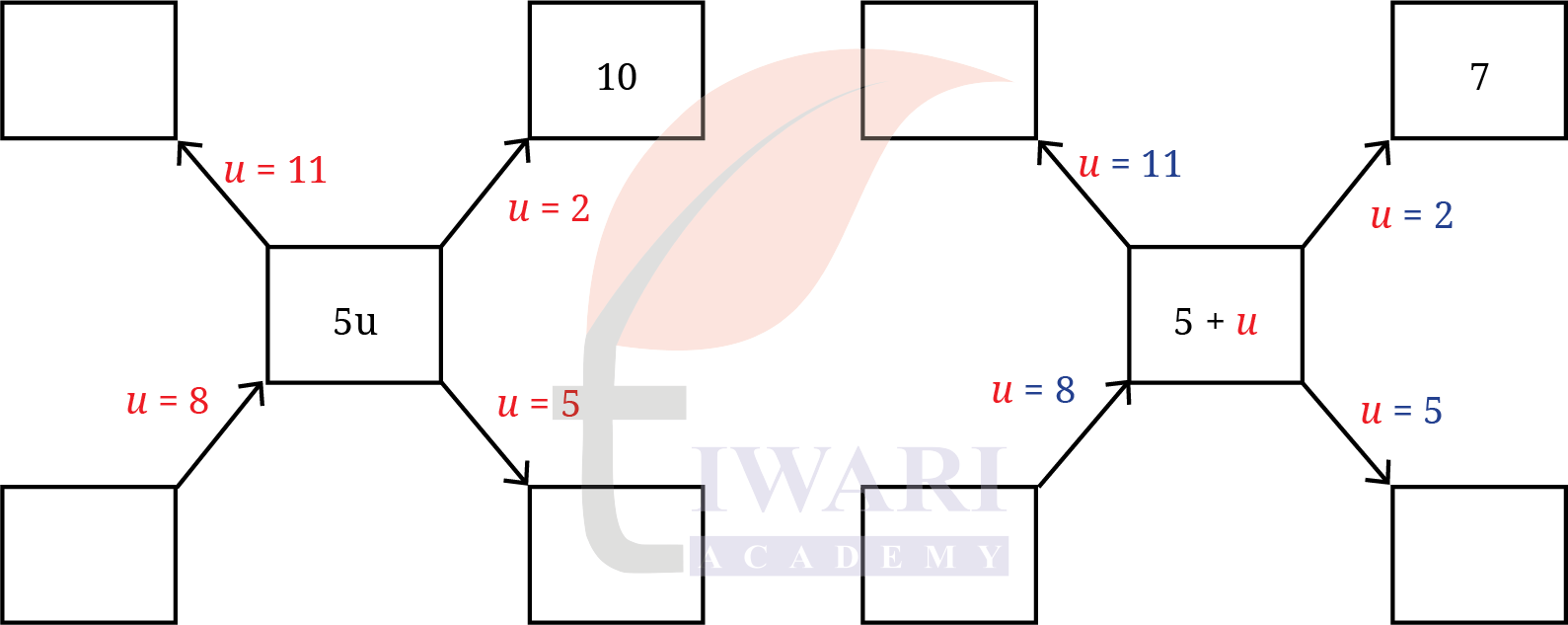
See SolutionIf u = 11: 5u = 5 × 11 = 55; 5 + u = 5 + 11 = 16. (Values differ)
If u = 2: 5u = 5 × 2 = 10; 5 + u = 5 + 2 = 7. (Values differ)
If u = 8: 5u = 5 × 8 = 40; 5 + u = 5 + 8 = 13. (Values differ)
If u = 5: 5u = 5 × 5 = 25; 5 + u = 5 + 5 = 10. (Values differ)
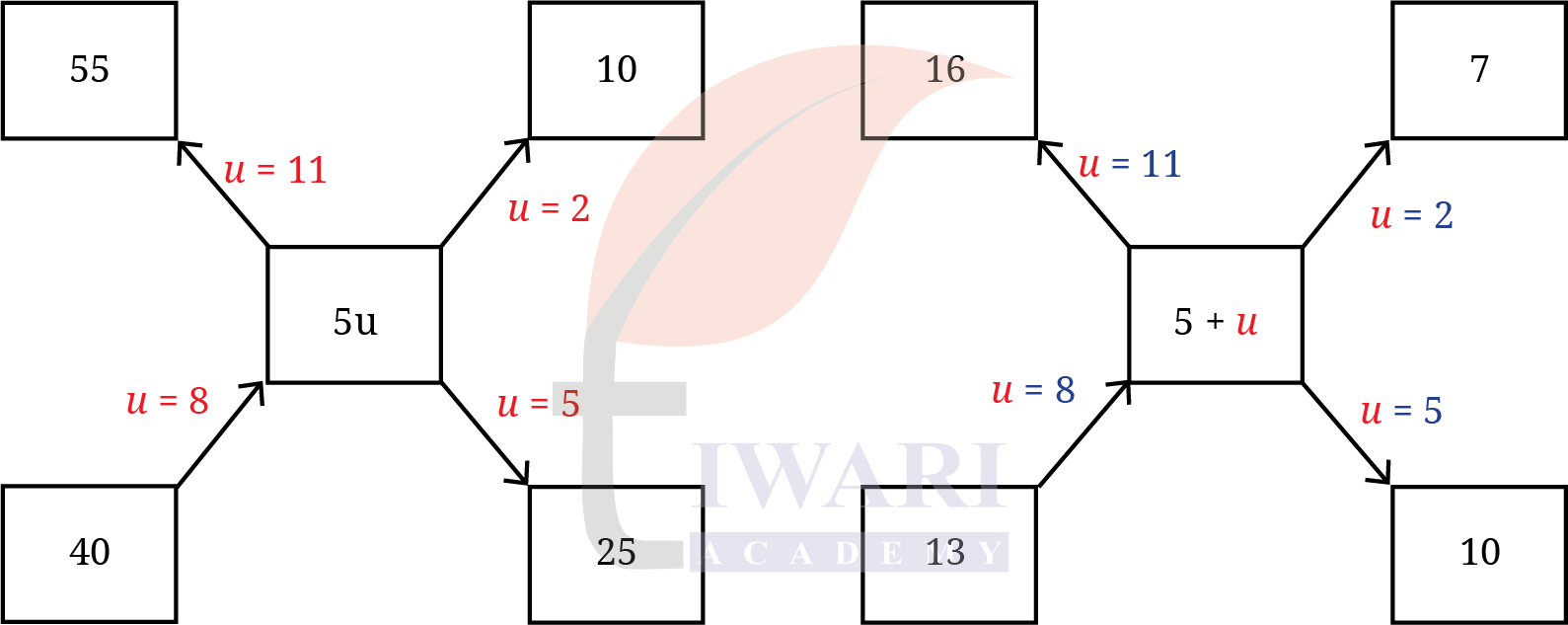
After filling in the two diagrams, do you think the two expressions are equal?
See SolutionNo, the expressions 10y-3 and 10(y-3) are not equal because they produce different values for the same value of y.
Example 11: What is the sum of the numbers in the picture (unknown values are denoted by letter-numbers)?
See SolutionThree ways to express the sum are shown:
1. Adding row wise: (4 × 3) + (r + s) + (r + s) + (4 × 3)
2. Adding like terms: (8 × 3) + (r + r) + (s + s)
3. Adding upper half and doubling: 2 × ((4 × 3) + r + s)
Simplification Check: All three expressions simplify to the same value: 24 + 2r + 2s.
Page 93
Figure it Out
1. Add the numbers in each picture below. Write their corresponding expressions and simplify them. Try adding the numbers in each picture in a couple different ways and see that you get the same thing.

See SolutionFigure 1: Column-wise
5y + x = – 4
Figure 2: Column-wise
1 = 2p + 3q
1 = 3q + 2p
Row-wise
2p + 3q = 1
3q + 2p = 1
Figure 3: Column-wise
-5g + 5k + 5k -5g = 10k – 10g
5k + 5k + 5k + 5k = 20k
5k + 5k + 5k + 5k = 20k
-5g + 5k + 5k -5g = 10k – 10g
Row-wise
-5g + 5k + 5k -5g = 10k – 10g
5k + 5k + 5k + 5k = 20k
5k + 5k + 5k + 5k = 20k
-5g + 5k + 5k -5g = 10k – 10g
The result is same either column-wise or row-wise addition.
2. Simplify each of the following expressions:
(a) p + p + p + p, p + p + p + q, p + q + p – q,
(b) p – q + p – q, p + q – p + q,
(c) p + q – (p + q), p – q – p – q
(d) 2d – d – d – d, 2d – d – d – c,
(e) 2d – d – (d – c), 2d – (d – d) – c,
(f) 2d – d – c – c
See Solution(a)
p + p + p + p = 4p
p + p + p + q = 3p + q
p + q + p – q = p + p + q – q = 2p
(b)
p – q + p – q = p + p – q – q = 2p – 2q
p + q – p + q = p – p + q + q = 0 + 2q = 2q
(c)
p + q – (p + q) = p + q – p – q = 0
p – q – p – q = p – p – q – q = –2q
(d)
2d – d – d – d = 2d – 3d = –d
2d – d – d – c = 2d – 2d – c = 0 – c = –c
(e)
2d – d – (d – c) = 2d – d – d + c = 0 + c = c
2d – (d – d) – c = 2d – 0 – c = 2d – c
(f)
2d – d – c – c = d – 2c
Mind the Mistake, Mend the Mistake
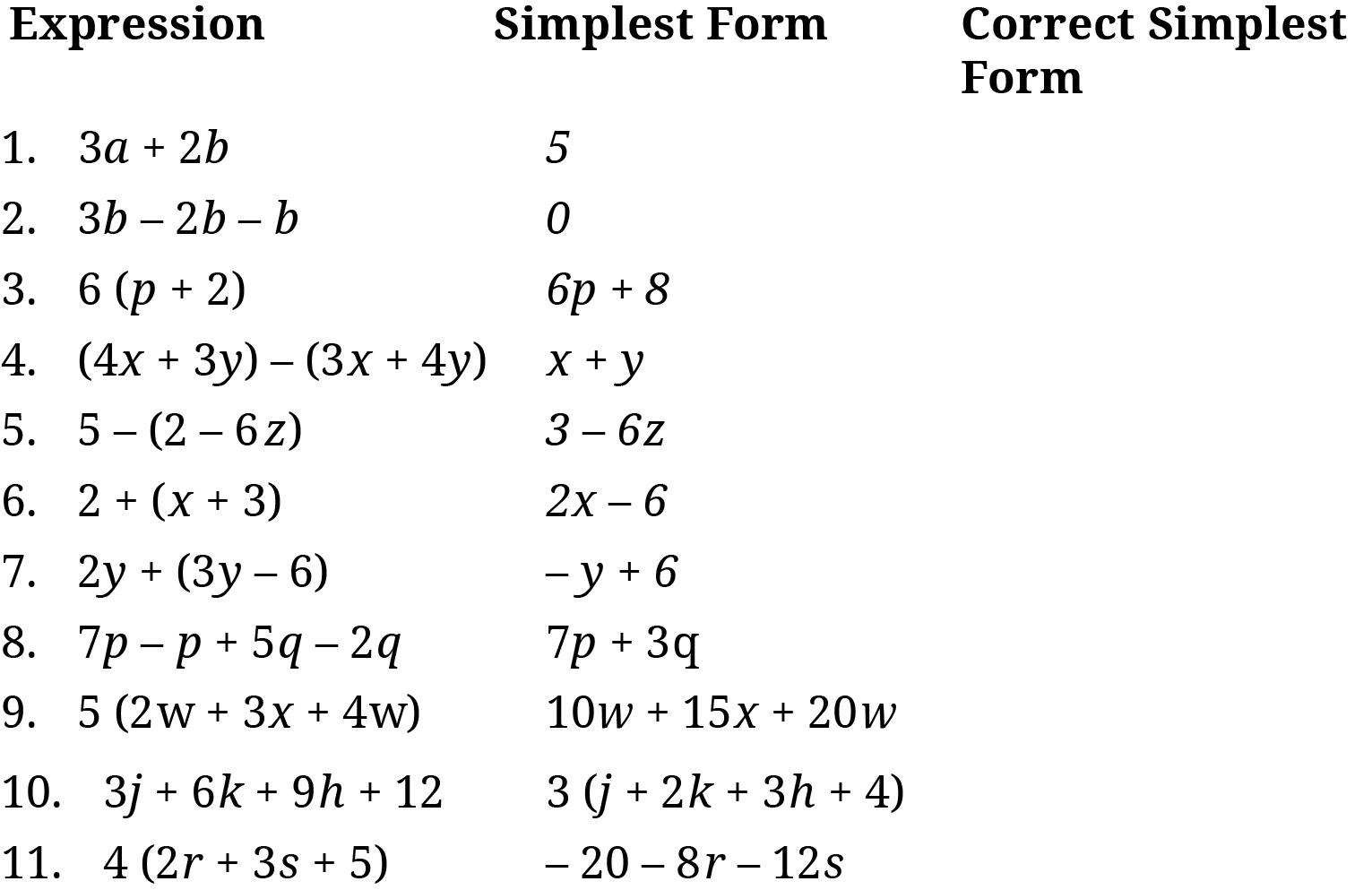
1. Expression: 3a + 2b. Given Simplest Form: 5.
See SolutionMistake: Yes. Added coefficients of unlike terms (a and b).
Explanation: Terms with different letter-numbers cannot be combined.
Correct Simplest Form: 3a + 2b (It’s already in simplest form).
2. Expression: 3b – 2b – b. Given Simplest Form: 0.
See SolutionMistake: No. (3 – 2 – 1)b = 0b = 0.
Correct Simplest Form: 0.
3. Expression: 6(p + 2). Given Simplest Form: 6p + 8.
See SolutionMistake: Yes. Incorrect distribution.
Explanation: 6 should multiply both p and 2. 6 × 2 = 12, not 8.
Correct Simplest Form: 6p + 12.
4. Expression: (4x + 3y) – (3x + 4y). Given Simplest Form: x + y.
See SolutionMistake: Yes. Incorrect subtraction of y terms.
Explanation: 4x + 3y – 3x – 4y
= (4x – 3x) + (3y – 4y)
= x + (-1y) = x – y.
The sign for the y term is wrong.
Correct Simplest Form: x – y.
5. Expression: 5 – (2 – 6z). Given Simplest Form: 3 – 6z.
See SolutionMistake: Yes. Incorrect sign change when removing bracket.
Explanation: When removing brackets preceded by a minus sign, the sign of each term inside changes. 5-(2 – 6z) = 5 – 2 + 6z = 3 + 6z.
The sign of 6z should be positive.
Correct Simplest Form: 3 + 6z.
6. Expression: 2 + (x + 3). Given Simplest Form: 2x – 6.
See SolutionMistake: Yes. Completely incorrect simplification.
Explanation: Removing brackets after ‘+’ does not change signs: 2 + x + 3. Combine number terms: x+(2 + 3) = x + 5.
The given form seems unrelated.
Correct Simplest Form: x + 5.
7. Expression: 2y + (3y – 6). Given Simplest Form: -y + 6.
See SolutionMistake: Yes. Incorrect addition of like terms and sign error.
Explanation: Removing brackets after ‘+’ does not change signs: 2y + 3y – 6. Combine like terms: (2 + 3)y – 6 = 5y – 6.
Correct Simplest Form: 5y – 6.
8. Expression: 7p – p + 5q – 2q. Given Simplest Form: 7p + 3q.
See SolutionMistake: Yes. Did not combine the p terms correctly.
Explanation: Combine p terms: 7p – p = (7-1)p = 6p.
Combine q terms: 5q – 2q = (5 – 2)q = 3q.
Result is 6p+3q.
Correct Simplest Form: 6p + 3q.
9. Expression: 5(2w + 3x + 4w). Given Simplest Form: 10w + 15x + 20w.
See SolutionMistake: Yes, the given form is not fully simplified.
Explanation: Although the distribution 5 × 2w + 5 × 3x + 5 × 4w = 10w + 15x + 20w is correct, the like terms (10w and 20w) should be combined.
Correct Simplest Form: (10w+20w) + 15x = 30w+15x. (Alternatively, simplify inside bracket first: 5(6w + 3x) = 30w + 15x).
10. Expression: 3j + 6k + 9h + 12. Given Simplest Form: 3(j + 2k + 3h + 4).
See SolutionMistake: No. The given form is a correctly factored equivalent expression (common factor 3 is taken out). Both 3j + 6k + 9h + 12 and 3(j + 2k + 3h + 4) are valid representations, with the first being expanded and the second factored. Neither is strictly “simpler” than the other in terms of combining terms, as all terms are unlike.
Correct Simplest Form: 3j + 6k + 9h + 12 (or the factored form 3(j + 2k + 3h + 4)).
11. Expression: 4 + (2r + 3s + 5). Given Simplest Form: -20 – 8r – 12s.
See SolutionMistake: Yes. Completely incorrect.
Explanation: Removing brackets after ‘+’ does not change the signs inside. 4 + 2r + 3s + 5.
Combine the constant terms: 2r + 3s + (4 + 5) = 2r + 3s + 9.
The given form appears unrelated, perhaps resulting from distributing a -4 by mistake.
Correct Simplest Form: 2r + 3s + 9.
Take a look at all the corrected simplest forms (i.e. brackets are removed, like terms are added and terms with only numbers are also added). Is there any relation between the number of terms and the number of letter-numbers these expressions have?
See SolutionYes, there is a relation between the number of terms in the simplest form and the number of different letter-numbers (variables) used in the expression.
When we simplify an expression:
Like terms (terms with the same variables) are combined, reducing the total number of terms.
The simplest form usually contains one term per unique letter-number and sometimes a constant term.
For example: An expression like 3x + 4x + 2 simplifies to 7x + 2 — 1 variable (x) and 1 constant → 2 terms.
An expression like 5a – 2b + 3a – b simplifies to 8a – 3b — 2 variables (a and b) → 2 terms.
So, in general, the number of terms in the simplified form corresponds to the number of different letter-numbers (variables) and constants present after combining all like terms.
4.5 Pick Patterns and Reveal Relationships
Find out the formula of this number machine.

See SolutionLet the inputs be a (left) and b (right). The formula is “two times the first number minus the second number”.
Algebraic expression: 2a – b.
Check:
a = 5, b = 2: 2(5) – 2 = 10 – 2 = 8. (Matches)
a = 8, b = 1: 2(8) – 1 = 16 – 1 = 15. (Matches)
a = 9, b = 11: 2(9) – 11 = 18 – 11 = 7. (Matches)
a = 10, b = 10: 2(10) – 10 = 20 – 10 = 10. (Matches)
a = 6, b = 4: 2(6) – 4 = 12 – 4 = 8.
The formula 2a – b works for all examples.

Page 96
Find the formulas of the number machines below and write the expression for each set of inputs.
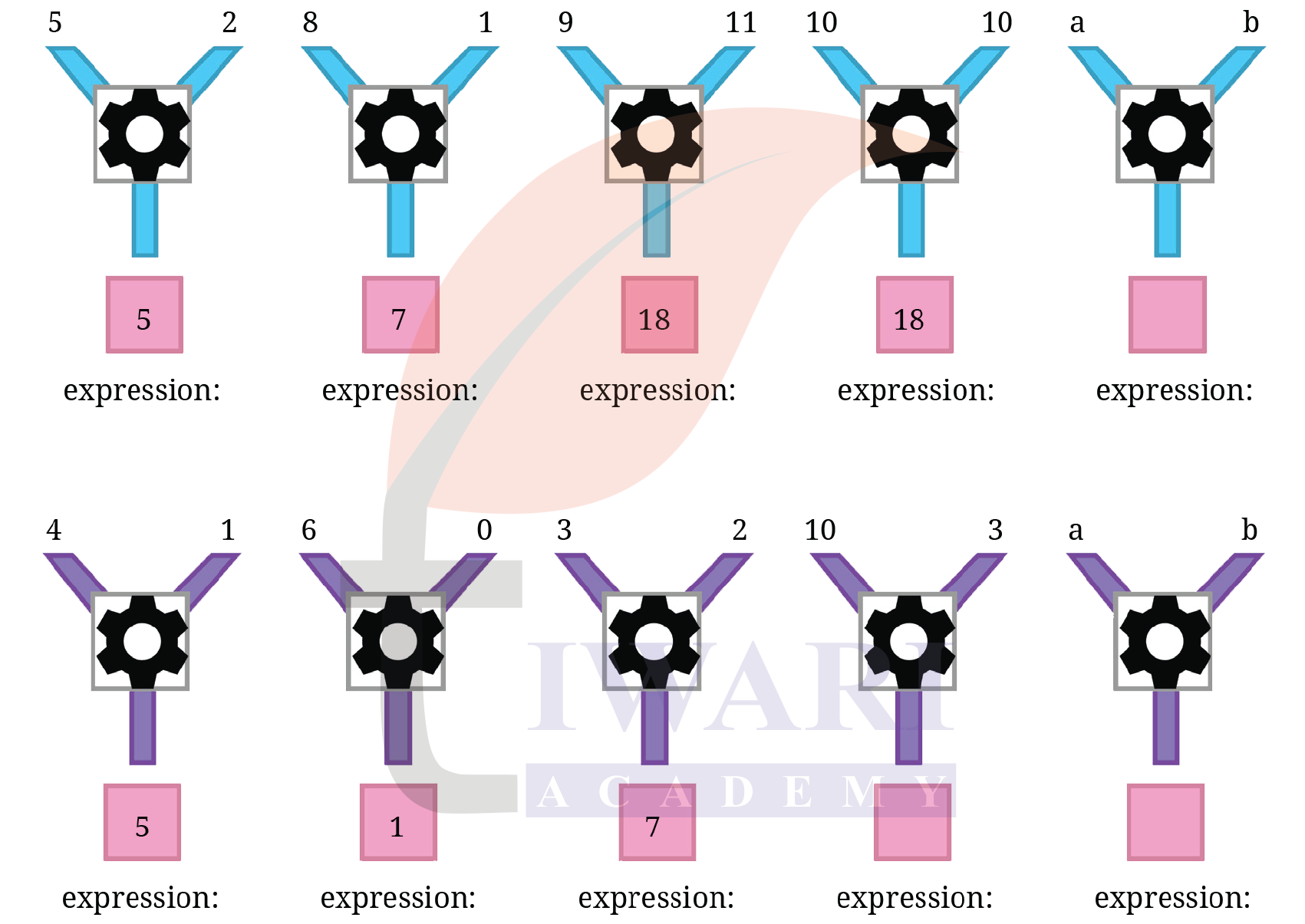
See SolutionLet inputs be a left, b right
Machine 1 Inputs/Outputs:
(5, 2) -> 5;
(8, 1) -> 7;
(9, 11) -> -2;
(10, 10) -> 0;
(a, b) -> ?
Let’s test simple formulas:
Check a + b – 2:
a = 5, b = 2: a + b – 2 = 5. (Output is 5 – Match)
a = 8, b = 1: a + b – 2 = 7. (Output is 7 – Match)
a = 9, b = 11: a + b – 2 = 18. (Output is 18 – Match)
a = 10, b = 10: a + b – 2 = 18. (Output is 18 – Match)
So, the formula for Machine I is a + b – 2.
Machine 2 Inputs/Outputs:
(4, 1) -> 18;
(6, 0) -> 18;
(3, 2) -> 11;
(10, 3) -> 33;
(a, b) -> ?
Let’s test potential formulas:
Try ab + 1:
a = 4, b = 1: 4 x 1 + 1 = 4 + 1 = 5 (Match)
a = 6, b = 0: 3 x 0 + 1 = 0 + 1 = 18 (Match)
a = 3, b = 2: 3 x 2 + 1 = 6 + 1 = 7 (Match)
a = 10, b = 3: 10 x 3 + 1 = 30 + 1 = 31 (Match)
Hence, the formula for Machine II is a x b + 1.
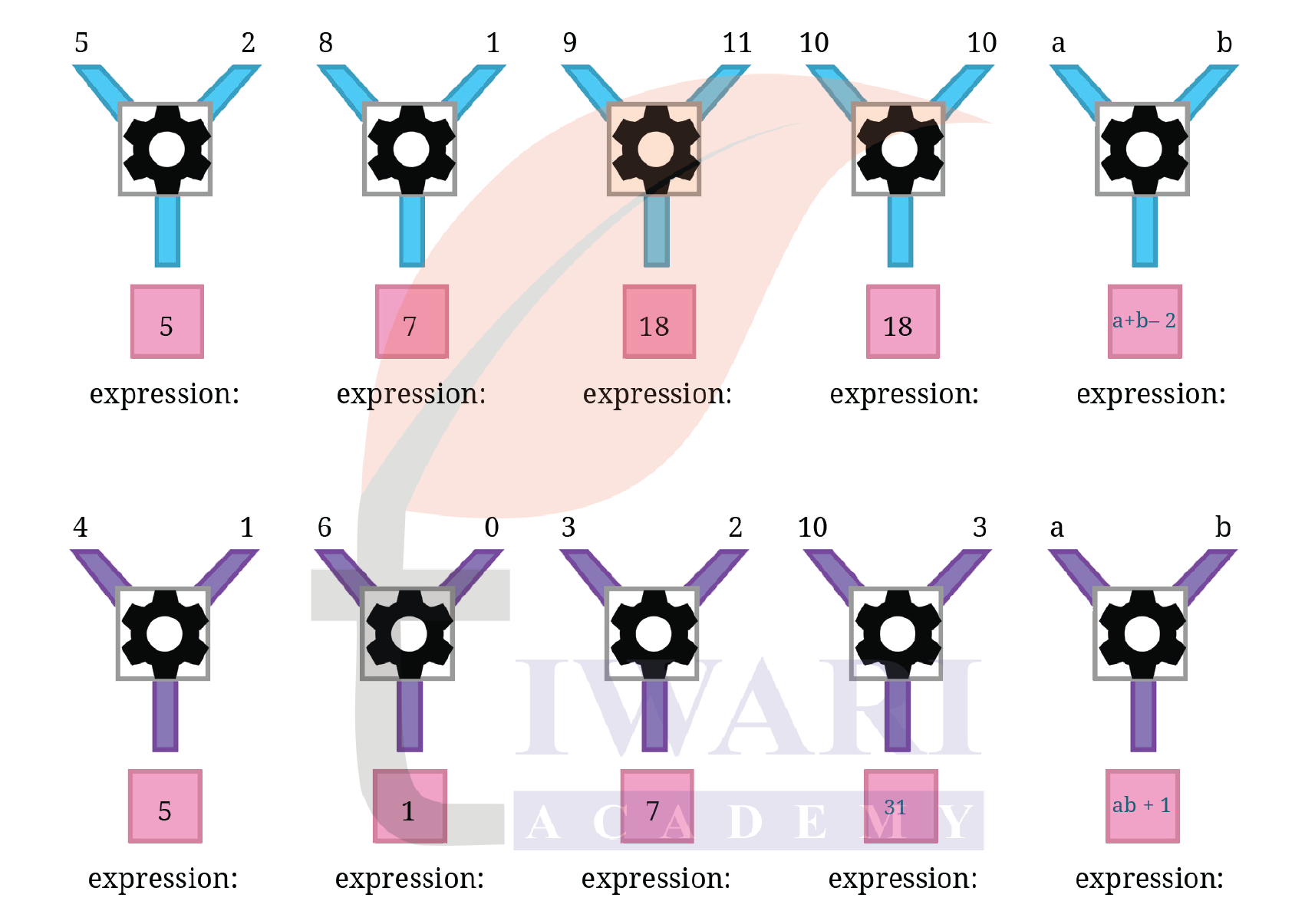
Example 12: Somjit noticed a repeating pattern along the border of a saree.

Somjit wonders if there is a way to describe all the positions where the (i) Design A occurs, (ii) Design B occurs and (iii) Design C occurs.
See SolutionDesign C appears at: 3, 6, 9, 12, …
These are multiples of 3, so the nth occurrence of Design C is at Position = 3n
Design B appears at: 2, 5, 8, 11, …
Each is one less than a multiple of 3, so position = 3n – 1
Design A appears at: 1, 4, 7, 10, …
Each is two less than a multiple of 3, so position = 3n – 2.
Where would design C appear for the nth time?
See SolutionWe can see that this design appears in positions that are multiples of
3. So the nth occurrence of Design C will be at position 3 × n (or 3n).
Similarly, find the formula that gives the position where the other Designs appear for the nth time.
See SolutionThe designs repeat every 3 positions:
Position: 1 2 3 4 5 6 7 8 9 10 11 12
Design: A B C A B C A B C A B C
Now, find the position of the nth occurrence of each design:
(i) Design A:
Appears at positions: 1, 4, 7, 10, …
These are: 3 × 1 – 2 = 1, 3 × 2 – 2 = 4, 3 × 3 – 2 = 7, …
Formula: Position = 3n – 2
(ii) Design B:
Appears at positions: 2, 5, 8, 11, …
These are: 3 × 1 – 1 = 2, 3 × 2 – 1 = 5, 3 × 3 – 1 = 8, …
Formula: Position = 3n – 1
(iii) Design C:
Appears at positions: 3, 6, 9, 12, …
These are: 3 × 1, 3 × 2, 3 × 3, …
Formula: Position = 3n
Given a position number can we find out the design that appears there? Which Design appears at Position 122?
See SolutionDivide 122 by 3:
122 ÷ 3 = 40 remainder 2
Remainder = 2
So, Design B appears at Position 122
Can the remainder obtained by dividing the position number by 3 be used for this? Observe the table below.
| Position no. | Quotient on division by 3 | Remainder |
|---|---|---|
| 99 | 33 | 0 |
| 122 | 40 | 2 |
| 148 | 49 | 1 |
See SolutionYes, the remainder obtained by dividing the position number by 3 can definitely be used to determine which design (A, B or C) appears at a given position.
Use this to find what design appears at positions 99, 122, and 148.
See SolutionPosition 99: 99 / 3 = 33 Remainder 0. Design: C.
Position 122: 122 / 3 = 40 Remainder 2. Design: B.
Position 148: 148 / 3 = 49 Remainder 1. Design: A.
Patterns in a Calendar
Will the diagonal sums be equal in every 2 × 2 square in this endless grid? How can we be sure?
See SolutionLet a is the top-left number of the 2×2 square.
a + 1 is to the right of a.
a + 7 is below a.
a + 8 is diagonally opposite to a.
Now Let’s Check Diagonal Sums:
First diagonal: a + (a + 8) = 2a + 8
Second diagonal: (a + 1) + (a + 7) = 2a + 8
Both diagonals give the same sum: 2a + 8
Yes, the diagonal sums will be equal in every 2 × 2 square of this endless calendar grid.
We can be sure of this because when we represent the numbers algebraically (using a), the two diagonal sums both simplify to the same expression, 2a + 8, regardless of the value of a.
This shows that the equality of diagonal sums is always true, not just a coincidence for some numbers.
Given that we know the top left number, how do we find the other numbers in this 2 × 2 square?
| a | ? |
|---|---|
| ? | ? |
See SolutionIn a standard calendar grid:
The number to the right of ‘a’ is one more: a + 1.
The number below ‘a’ is seven more: a + 7.
The number diagonal to ‘a’ (below and right) is eight more: a + 8.
The general 2 x 2 square can be represented as:
a a+1
a+7 a+8
| a | a + 1 |
|---|---|
| a + 7 | a + 8 |
Find the sum of all the numbers. Compare it with the number in the centre. Repeat for another set. What do you observe?
See SolutionIf Center 15:
Numbers are 8, 14, 15, 16, 22.
Sum = 8 + 14 + 15 + 16 + 22 = 75.
The sum (75) is 5 times the centre number (15).
So, 5 × 15 = 75.
If Center 11:
Numbers are 4 (above), 10 (left), 11 (center), 12 (right), 18 (below).
Sum = 4 + 10 + 11 + 12 + 18 = 55.
The sum (55) is 5 times the centre number (11).
So, 5 × 11 = 55.
Observation: The sum of the numbers in the ‘+’ shape appears to be always 5 times the centre number.
Will this always happen? How do you show this?
See SolutionYes, it will always happen. We can show this using algebra.
Algebraic Proof:
Let the centre number be ‘a’.
The number above ‘a’ is a-7.
The number below ‘a’ is a + 7.
The number to the left of ‘a’ is a – 1.
The number to the right of ‘a’ is a + 1.
The five numbers in the ‘+’ shape are: (a – 7), (a – 1), a, (a + 1), (a + 7).
Sum = (a – 7) + (a – 1) + a + (a + 1) + (a + 7)
= a – 7 + a – 1 + a + a + 1 + a + 7
= (a + a + a + a + a) + (-7 + 7) + (-1 + 1) (Grouping like terms)
= 5a + 0 + 0
= 5a.
The sum is always 5a, which is 5 times the centre number.
Page 100
How many matchsticks will there be in Step 33, Step 84 and Step 108? Of course, we can draw and count, but is there a quicker way to find the answers using the pattern present here?
See SolutionPattern:
Step 1 has 1 triangle and 3 matchsticks.
Step 2 has 2 triangles and 5 matchsticks.
Step 3 has 3 triangles and 7 matchsticks.
Since, the number of matchsticks increases by 2 with each new step, so, we can use the formula: 2y + 1
Now, matchsticks for following steps:
Step 33:
Matchsticks = 2 × 33 + 1 = 66 + 1 = 67
Step 84:
Matchsticks = 2 × 84 + 1 = 168 + 1 = 169
Step 108:
Matchsticks = 2 × 108 + 1 = 216 + 1 = 217
Page 101
Does the above expression also give the number of matchsticks at each step correctly? Are these expressions the same?
See SolutionIn the context of the triangle matchstick pattern, two expressions were formed to calculate the number of matchsticks at Step y:
Expression 1: 2y + 1
A simplified form directly expressing the total sticks at step y.
Expression 2: 3 + 2 × (y – 1)
This accounts for the first triangle using 3 sticks and every new triangle adds 2 more.
Simplifying this expression, we get:
3 + 2 × (y – 1)
= 3 + 2y – 2
= (3 – 2) + 2y
= 1 + 2y
= 2y + 1
This shows that both expressions are the same.
What are these numbers in Step 3 and Step 4?
See SolutionStep 3: 2 × 3 + 1 = 6 + 1 = 7 matchsticks
Step 4: 2 × 4 + 1 = 8 + 1 = 9 matchsticks
How does the number of matchsticks change in each orientation as the steps increase? Write an expression for the number of matchsticks at Step ‘y’ in each orientation. Do the two expressions add up to 2y + 1?
See SolutionTwo Orientations of Matchsticks
Each triangle in the pattern is made using:
Horizontal matchsticks – at the top and bottom
Diagonal matchsticks – connecting the sides
Now analyze how the number of matchsticks changes in each orientation as the steps increase.
Horizontal Orientation:
At Step 1: 1 horizontal stick (bottom)
At Step 2: 2 horizontal sticks (bottom of each triangle)
At Step 3: 3 horizontal sticks
So, at Step y: y horizontal matchsticks
Expression: y
Diagonal Orientation:
Now count the diagonal sticks (the middle “upside” sides of each triangle):
At Step 1: 2 diagonal matchsticks
At Step 2: 3 diagonal matchsticks
At Step 3: 4 diagonal matchsticks
So, at Step y: (y + 1) diagonal matchsticks
Expression: y + 1
Total Matchsticks:
Total matchsticks = Horizontal + Diagonal
= y + (y + 1)
= 2y + 1
Page 102
Figure it Out
1. One plate of Jowar roti costs ₹30 and one plate of Pulao costs ₹20. If x plates of Jowar roti and y plates of pulao were ordered in a day, which expression(s) describe the total amount in rupees earned
that day?
(a) 30x + 20y (b) (30 + 20)×(x + y)
(c) 20x + 30y (d) (30 + 20) × x + y
(e) 30x – 20y
See SolutionCost of Jowar roti
= (Price per plate) × (Number of plates)
= 30 × x = 30x.
Cost of Pulao
= (Price per plate) × (Number of plates)
= 20 × y = 20y.
Total amount earned
= (Cost of Jowar roti) + (Cost of Pulao)
= 30x + 20y.
The correct expression is (a) 30x + 20y.
2.Pushpita sells two types of flowers on Independence day: champak and marigold. ‘p’ customers only bought champak, ‘q’ customers only bought marigold and ‘r’ customers bought both. On the same day, she gave away a tiny national flag to every customer. How many flags did she give away that day?
(a) p + q + r (b) p + q + 2r
(c) 2 × (p + q + r) (d) p + q + r + 2
(e) p + q + r + 1 (f) 2 × (p + q)
See SolutionThe total number of unique customers is the sum of those who bought only champak, those who bought only marigold, and those who bought both.
Total customers = p + q + r.
Since each customer gets one flag, the total number of flags given away is p + q + r.
The correct expression is (a) p + q + r.
3. A snail is trying to climb along the wall of a deep well. During the day it climbs up ‘u’ cm and during the night it slowly slips down ‘d’ cm. This happens for 10 days and 10 nights.
(a) Write an expression describing how far away the snail is from its starting position.
See SolutionExpression for distance from starting point:
Each day–night cycle, the snail climbs u cm and slips back d cm.
So, net gain per day = u – d cm
Over 10 such cycles, total net climb = 10 × (u – d)
Expression: 10(u – d)
(b) What can we say about the snail’s movement if d > u?
See SolutionWhat if d > u?
If the snail slips down more at night than it climbs during the day, i.e., d > u,
then u – d becomes negative.
So, the expression becomes: 10(u – d) = negative value
Conclusion: If d > u, the snail is actually moving downward overall—i.e., it is slipping further down the well over time instead of climbing up.
4. Radha is preparing for a cycling race and practices daily. The first week she cycles 5 km every day. Every week she increases the daily distance cycled by ‘z’ km. How many kilometers would Radha have cycled after 3 weeks?
See SolutionWeek 1:
Daily distance = 5 km.
Weekly total = 7 × 5 = 35 km.
Week 2:
Daily distance = 5 + z km.
Weekly total = 7 × (5+z) = 35 + 7z km.
Week 3:
Daily distance = (5 + z) + z = 5 + 2z km.
Weekly total = 7 × (5 + 2z) = 35 + 14z km.
Total distance after 3 weeks = Sum of weekly totals
Total = 35 + (35 + 7z) + (35 + 14z)
= (35 + 35 + 35) + (7z + 14z)
= 105 + 21z km.
5. In the following figure, observe how the expression w + 2 becomes 4w + 20 along one path. Fill in the missing blanks on the remaining paths. The ovals contain expressions and the boxes contain operations.

Answer:

6. A local train from Yahapur to Vahapur stops at three stations at equal distances along the way. The time taken in minutes to travel from one station to the next station is the same and is denoted by t. The train stops for 2 minutes at each of the three stations.
(a) If t = 4, what is the time taken to travel from Yahapur to Vahapur?
See SolutionTotal travel segments = 4.
Travel time = 4 x t = 4 x 4 = 16 minutes.
Number of stops = 3.
Stop time = 3 x 2 = 6 minutes.
Total time
= Travel time + Stop time
= 16 + 6
= 22 minutes.
(b) What is the algebraic expression for the time taken to travel from Yahapur to Vahapur? [Hint: Draw a rough diagram to visualise the situation]
See SolutionTotal travel time = 4 x t = 4t.
Total stop time = 3 x 2 = 6.
Total time expression = 4t + 6.
7. Simplify the following expressions:
(a) 3a + 9b – 6 + 8a – 4b – 7a + 16
(b) 3 (3a – 3b) – 8a – 4b – 16
(c) 2 (2x – 3) + 8x + 12
(d) 8x – (2x – 3) + 12
(e) 8h – (5 + 7h) + 9
(f) 23 + 4(6m – 3n) – 8n – 3m – 18
See Solution(a) 3a + 9b – 6 + 8a – 4b – 7a + 16
= (3a + 8a – 7a) + (9b – 4b) + (-6 + 16)
= 4a + 5b + 10.
(b) 3(3a – 3b) – 8a – 4b – 16
= 9a – 9b – 8a – 4b – 16
= (9a – 8a) + (-9b – 4b) – 16
= a – 13b – 16.
(c) 2(2x – 3) + 8x + 12
= 4x – 6 + 8x + 12
= (4x + 8x) + (-6 + 12)
= 12x + 6.
(d) 8x – (2x – 3) + 12
= 8x – 2x + 3 + 12
= (8x – 2x) + (3 + 12)
= 6x + 15.
(e) 8h – (5 + 7h) + 9
= 8h – 5 – 7h + 9
= (8h-7h) + (-5+9)
= h + 4.
(f) 23 + 4(6m – 3n) – 8n – 3m – 18
= 23 + 24m – 12n – 8n – 3m – 18
= (24m-3m) + (-12n-8n) + (23-18)
= 21m – 20n + 5.
8. Add the expressions given below:
(a) 4d – 7c + 9 and 8c – 11 + 9d
(b) – 6f + 19 – 8s and – 23 + 13f + 12s
(c) 8d – 14c + 9 and 16c – (11 + 9d)
(d) 6f – 20 + 8s and 23 – 13f – 12s
(e) 13m – 12n and 12n – 13m
(f) – 26m + 24n and 26m – 24n
See Solution(a) (4d – 7c + 9) + (8c – 11 + 9d)
= (4d + 9d) + (-7c + 8c) + (9 – 11)
= 13d + c – 2.
(b) (-6f + 19 – 8s) + (-23 + 13f + 12s)
= (-6f + 13f) + (-8s + 12s) + (19 – 23)
= 7f + 4s – 4.
(c) (8d – 14c + 9) + (16c – (11 + 9d))
= 8d – 14c + 9 + 16c – 11 – 9d
= (8d – 9d) + (-14c + 16c) + (9 – 11)
= -d + 2c – 2.
(d) (6f – 20 + 8s) + (23 – 13f – 12s)
= (6f – 13f) + (8s – 12s) + (-20 + 23)
= -7f – 4s + 3.
(e) (13m – 12n) + (12n – 13m)
= (13m – 13m) + (-12n + 12n)
= 0 + 0 = 0.
(f) (-26m + 24n) + (26m – 24n)
= (-26m + 26m) + (24n – 24n)
= 0 + 0 = 0.
9. Subtract the expressions given below:
(a) 9a – 6b + 14 from 6a + 9b – 18
(b) – 15x + 13 – 9y from 7y – 10 + 3x
(c) 17g + 9 – 7h from 11 – 10g + 3h
(d) 9a – 6b + 14 from 6a – (9b + 18)
(e) 10x + 2 + 10y from –3y +8 – 3x
(f) 8g + 4h – 10 from 7h – 8g + 20
See Solution(a) 9a – 6b + 14 from 6a + 9b – 18
= (6a + 9b – 18) – (9a – 6b + 14)
= 6a + 9b – 18 – 9a + 6b – 14
= (6a – 9a) + (9b + 6b) + (-18 – 14)
= -3a + 15b – 32.
(b) -15x + 13 – 9y from 7y – 10 + 3x
= (7y – 10 + 3x) – (-15x + 13 – 9y)
= 7y – 10 + 3x + 15x – 13 + 9y
= (3x + 15x) + (7y + 9y) + (-10 – 13)
= 18x + 16y – 23.
(c) 17g + 9 – 7h from 11 – 10g + 3h
= (11 – 10g + 3h) – (17g + 9 – 7h)
= 11 – 10g + 3h – 17g – 9 + 7h
= (-10g – 17g) + (3h + 7h) + (11 – 9)
= -27g + 10h + 2.
(d) 9a – 6b + 14 from 6a – (9b + 18)
= (6a – (9b + 18)) – (9a – 6b + 14)
= (6a – 9b – 18) – (9a – 6b + 14)
= 6a – 9b – 18 – 9a + 6b – 14
= (6a – 9a) + (-9b + 6b) + (-18 – 14)
= -3a – 3b – 32.
(e) 10x + 2 + 10y from -3y + 8 – 3x
= (-3y + 8 – 3x) – (10x + 2 + 10y)
= -3y + 8-3x – 10x – 2 – 10y
= (-3x – 10x) + (-3y – 10y) + (8 – 2)
= -13x – 13y + 6.
(f) 8g + 4h – 10 from 7h – 8g + 20
= (7h – 8g + 20) – (8g + 4h – 10)
= 7h – 8g + 20 – 8g – 4h + 10
= (-8g – 8g) + (7h – 4h) + (20 + 10)
= -16g + 3h + 30.
10. Describe situations corresponding to the following algebraic
expressions:
(a) 8x + 3y
See SolutionSituation example: Total cost of buying x items at ₹8 each and y items at ₹3 each.
(b) 15x – 2x
See SolutionSituation example: The amount remaining if we start with 15 bags each containing x items and we remove 2 of those bags. (This simplifies to 13x).
11. Imagine a straight rope. If it is cut once as shown in the picture, we get 2 pieces. If the rope is folded once and then cut as shown, we get 3 pieces. Observe the pattern and find the number of pieces if the rope is folded 10 times and cut. What is the expression for the number of pieces when the rope is folded r times and cut?
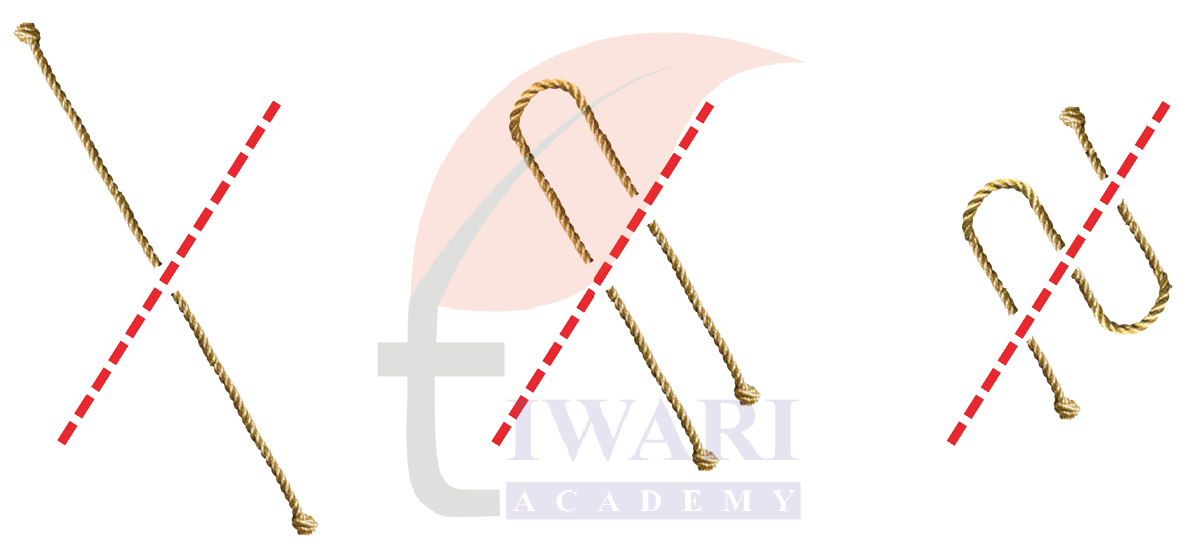
See SolutionCutting a Folded Rope
0 fold 1 cut → 2 pieces
1 fold 1 cut → 3 pieces
2 folds 1 cut → 4 pieces
3 folds 1 cut → 5 pieces
We observe that each fold adds one more piece.
Pattern:
At 0 folds, we get 2 pieces
At 1 fold, we get 3 pieces
At r folds, we get (r + 2) pieces
12. Look at the matchstick pattern below. Observe and identify the pattern. How many matchsticks are required to make 10 such squares. How many are required to make w squares?

See SolutionPattern observation:
1 square = 4 sticks.
2 squares = 7 sticks.
3 squares = 10 sticks.
Each new square adds 3 sticks to the previous figure.
Rule: Start with 4 sticks for the first square, then add 3 sticks for each additional square (w-1 additional squares).
Formula: Sticks = 4 + 3 × (w-1) = 4 + 3w – 3 = 3w + 1.
For 10 squares (w=10): Sticks = 3(10) + 1 = 30 + 1 = 31.
For w squares: Expression is 3w + 1.
13. Have you noticed how the colours change in a traffic signal? The sequence of colour changes is shown below.
Find the colour at positions 90, 190, and 343. Write expressions to describe the positions for each colour.

See SolutionThis is a 3-cycle pattern. Use remainder when position is divided by 3:
Remainder 1 -> Red
Remainder 2 -> Yellow
Remainder 0 -> Green
Position 90: 90 / 3 = 30 R 0. Colour: Green.
Position 190: 190 / 3 = 63 R 1. Colour: Red.
Position 343: 343 / 3 = 114 R 1. Colour: Red.
Expressions (for n = 1, 2, 3, …):
Red positions: 3n – 2
Yellow positions: 3n – 1
Green positions: 3n
14. Observe the pattern below. How many squares will be there in Step 4, Step 10, Step 50? Write a general formula. How would the formula change if we want to count the number of vertices of all the squares?

See SolutionSquares pattern:
Step 1 = 5 squares
Step 2 = 9 squares
Step 3 = 13 squares.
Adds 4 squares each step or follow the formula: 4n + 1.
Step 4: 4(4) + 1 = 17 squares.
Step 10: 4(10) + 1 = 41 squares.
Step 50: 4(50) + 1 = 201 squares.
Vertices pattern:
Step 1 (5 square): 20 vertices.
Step 2 (9 squares): 36 vertices.
Step 3 (13 squares): 52 vertices.
Formula for vertices in Step n: 4(4n + 1).
15. Numbers are written in a particular sequence in this endless 4-column grid.
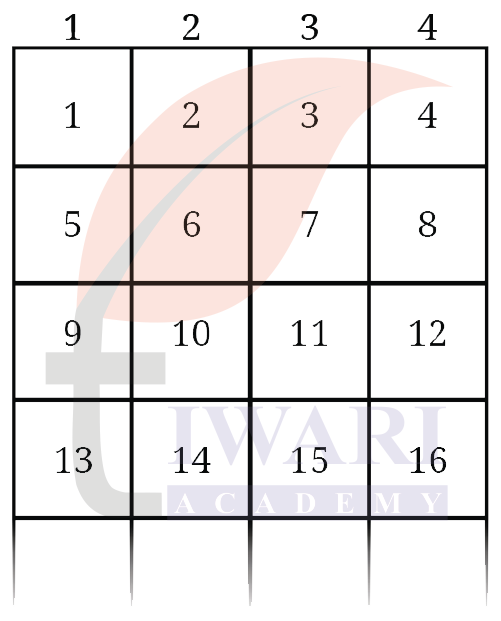
(a) Give expressions to generate all the numbers in a given column (1, 2, 3,
4).
See SolutionColumn 1 (1, 5, 9, …):
Numbers are 3 less than a multiple of 4.
Expression: 4r – 3.
Column 2 (2, 6, 10, …):
Numbers are 2 less than a multiple of 4.
Expression: 4r – 2.
Column 3 (3, 7, 11, …):
Numbers are 1 less than a multiple of 4.
Expression: 4r – 1.
Column 4 (4, 8, 12, …):
Numbers are multiples of 4.
Expression: 4r.
(b) In which row and column will the following numbers appear:
(i) 124
(ii) 147
(iii) 201
See SolutionDivide the given number N by 4: N = 4q + R (where R is the remainder).
If R = 1, it’s in Column 1, Row q + 1.
If R = 2, it’s in Column 2, Row q + 1.
If R = 3, it’s in Column 3, Row q + 1.
If R = 0, it’s in Column 4, Row q.
(i) 124:
124/4 = 31 Remainder 0.
Column 4, Row 31.
(ii) 147:
147/4 = 36 Remainder 3.
Column 3, Row 36 + 1 = 37.
(iii) 201:
201/4 = 50 Remainder 1.
Column 1, Row 50 + 1 = 51.
(c) What number appears in row r and column c?
See SolutionBased on the formulas in (a) or by observing the pattern:
Number = 4 x (Previous Row Number) + Column Number.
Formula: 4(r-1) + c.
Checking for Row 3, Col 2:
4(3 – 1) + 2
= 4(2) + 2
= 8 + 2 = 10.
(Correct).
(d) Observe the positions of multiples of 3. Do you see any pattern in it? List other patterns that you see.
See SolutionMultiples of 3 positions:
3(R1,C3), 6(R2,C2), 9(R3,C1), 12(R3,C4), 15(R4,C3), 18(R5,C2), …
The column pattern for multiples of 3 is C3, C2, C1, C4, C3, C2, C1, C4, … repeating every 4 terms.
Other patterns: Numbers in Column 4 are always multiples of 4.
Numbers in Column 2 are always even, but not multiples of 4.
Numbers in Columns 1 and 3 are always odd.
What is the main concept of Class 7 Maths Ganita Prakash Chapter 4?
Class 7 Maths Ganita Prakash Chapter 4 focuses on introducing the concept of algebraic expressions using letter-numbers (variables). Students learn how to represent real-life situations using letters and numbers together to form meaningful mathematical expressions. NCERT Math chapter 4 helps in developing the skill to describe patterns, relationships and rules in a concise manner. By replacing numbers with letters, students begin to generalize arithmetic operations, which is the foundation of algebra.
How does Class 7 Maths Ganita Prakash Chapter 4 help in real-life problem solving?
Class 7 Maths Ganita Prakash Chapter 4 shows students how mathematics can be used in everyday life through real-life examples like calculating ages, money spent on items or analyzing patterns. For instance, using variables like ‘c’ for the number of coconuts or ‘j’ for kilograms of jaggery helps students form expressions like 35c + 60j to find total cost. It encourages logical thinking, helping students move from specific numbers to general rules—an essential life skill in budgeting, measurements and planning.
What are like terms in Class 7 Maths Ganita Prakash Chapter 4?
Like terms are terms that have the same variables raised to the same power. For example, in the expression 5c + 3c + 10c, all the terms contain the variable ‘c’ and can be combined to form 18c. This concept is very important for simplifying algebraic expressions. Class 7 Maths Chapter 4 teaches students how to group and add or subtract like terms while leaving unlike terms (like 5c and 3d) unchanged. This builds the foundation for higher algebra.
What kind of questions can we expect from Class 7 Maths Ganita Prakash Chapter 4 in exams?
Exam questions from Class 7 Maths Ganita Prakash Chapter 4 test the understanding of forming and simplifying algebraic expressions. Students may be asked to represent situations using expressions (like perimeters, costs or patterns), identify mistakes in simplifications or apply expressions to solve numerical problems. Pattern-based questions like matchstick designs or number sequences are also common. Class 7 Maths Chapter 4 encourages observation, pattern recognition and logical reasoning—skills that are often assessed through application-based and story-form questions.


